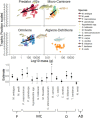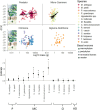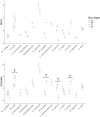Intraspecific body size determines isotopic trophic structure of a large river fish community
- PMID: 40485440
- PMCID: PMC12214442
- DOI: 10.1111/1365-2656.70069
Intraspecific body size determines isotopic trophic structure of a large river fish community
Abstract
Food web interactions are generally considered to be size-structured and occur at the individual or group level within species, yet many ecological models and tests of theory assign species-level values to define trophic position or niches. Such studies ignore potential ontogenetic or within-species size-based changes in consumer behaviour and trophic dynamics that can occur as individuals grow. We use stable isotope analysis of δ15N and δ13C to explore the effects of body size on fish community trophic structure and niches in one of Australia's largest river basins-the Murray-Darling. First, we test whether Trophic Position (TP) and δ13C scale with body mass within and among species and functional guilds (predator; micro-carnivore; omnivore; algivore-detritivore). Secondly, we test whether isotopic niche breadth scales with body size within and among species or community mass-classes ranging from <1 to >8192 g. There were positive relationships between individual body mass and TP or δ13C in 12/14 species, including two predators, seven micro-carnivores and three omnivores, but not in an algivore-detritivore. In contrast to the positive size-based scaling of TP and δ13C within species, no scaling relationship was found between TP or δ13C and body mass among species. Bayesian ellipses fitted to TP and δ13C showed that isotopic trophic niche breadth varied within and among species, but did not scale positively or negatively with body mass at any level of biological organisation. The importance of within-species, size-based, trophic structure in our study contrasts with previous evidence suggesting that river food webs are not size-structured. Food web models and tests of theory which have assumed a single, species-level, TP or δ13C do not capture the complex intraspecific size-based trophic dynamics of river fish communities. In contrast, our niche breadth results suggest that the isotopic diversity of food resources supporting the fish community did not scale with body size. These contrasting results may be explained by optimal foraging whereby larger predators, micro-carnivores and omnivores of some species selectively feed on higher energy, higher TP and δ13C-enriched resources whilst avoiding lower energy, lower TP and δ13C-depleted food items.
Keywords: body mass; food web; intraspecific; niche width; ontogenetic; stable isotope; trophic niche shift.
© 2025 The Author(s). Journal of Animal Ecology published by John Wiley & Sons Ltd on behalf of British Ecological Society.
Conflict of interest statement
None declared.
Figures



Similar articles
-
Resource use, niche width, and trophic position reveal diverse trophic structure in a tidal freshwater zone fish community.J Fish Biol. 2025 Jun;106(6):1876-1888. doi: 10.1111/jfb.16057. Epub 2025 Feb 25. J Fish Biol. 2025. PMID: 40000905 Free PMC article.
-
Habitat dimensionality and feeding strategies but not temperature as determinants of body size-trophic structure relationship in a marine food web.J Anim Ecol. 2024 Dec;93(12):1910-1923. doi: 10.1111/1365-2656.14199. Epub 2024 Oct 30. J Anim Ecol. 2024. PMID: 39473277
-
Spatial, environmental and trophic niche partitioning by seabirds in a climate change hotspot.J Anim Ecol. 2025 Apr;94(4):582-596. doi: 10.1111/1365-2656.14245. Epub 2025 Jan 26. J Anim Ecol. 2025. PMID: 39865930 Free PMC article.
-
A global assessment of large terrestrial carnivore kill rates.Biol Rev Camb Philos Soc. 2025 Feb;100(1):327-350. doi: 10.1111/brv.13143. Epub 2024 Sep 11. Biol Rev Camb Philos Soc. 2025. PMID: 39262094 Free PMC article.
-
Falls prevention interventions for community-dwelling older adults: systematic review and meta-analysis of benefits, harms, and patient values and preferences.Syst Rev. 2024 Nov 26;13(1):289. doi: 10.1186/s13643-024-02681-3. Syst Rev. 2024. PMID: 39593159 Free PMC article.
References
-
- Arim, M. , Abades, S. R. , Laufer, G. , Loureiro, M. , & Marquet, P. A. (2010). Food web structure and body size: Trophic position and resource acquisition. Oikos, 119, 147–153.
-
- Arim, M. , Bozinovic, F. , & Marquet, P. A. (2007). On the relationship between trophic position, body mass and temperature: Reformulating the energy limitation hypothesis. Oikos, 116, 1524–1530.
-
- Arrington, D. A. , & Winemiller, K. O. (2002). Preservation effects on stable isotope analysis of fish muscle. Transactions of the American Fisheries Society, 131, 337–342.
-
- Bice, C. M. , Giatas, G. C. , Brewer, E. A. , Catalano, S. , Furst, D. , Oliver, R. , Revill, A. T. , Shiel, R. , Ye, Q. , & Zampatti, B. P. (2023). Commonwealth Environmental Water Holder Monitoring, Evaluation and Research Project: Lower Murray 2019–2022 Research Report. Diet and basal carbon sources of early life stage Murray cod in the Lower Murray River. South Australian Research and Development Institute, Aquatic Sciences.
-
- Blanchard, J. L. , Heneghan, R. F. , Everett, J. D. , Trebilco, R. , & Richardson, A. J. (2017). From bacteria to whales: Using functional size spectra to model marine ecosystems. Trends in Ecology & Evolution, 32, 174–186. - PubMed
Publication types
MeSH terms
Substances
Associated data
Grants and funding
LinkOut - more resources
Full Text Sources

